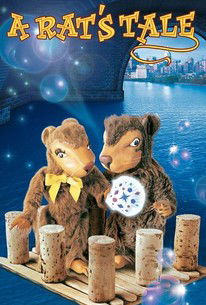"Moral Values Prevail"

| None | Light | Moderate | Heavy | |
|---|---|---|---|---|
| Language | ||||
| Violence | ||||
| Sex | ||||
| Nudity |
What You Need To Know:
A RAT’S TALE is a marionette movie from Germany. Awkwardly shot in its first half, the movie picks up the pace in the second half with an entertaining story of good defeating evil. A RAT’S TALE tells the story of a community of rats in New York City threatened by a real estate developer, named Dollart, who wants to exterminate them with a terrible poison. Two young rats named Monty and Isabella, with the help of a funny, talkative “canaligator” from the bayou named Jean Paul, use three shells to find a hidden land where a plant antidote to the poison grows in abundance. They return with some plants just in time to save Dollart, who is dying after accidentally getting a big whiff of his own pesticide. In gratitude, Dollart decides to build an animal preserve instead.
Featuring the Augsburger Puppets, A RAT’S TALE is a film made for younger children age 10 or less. A RAT’S TALE contains New Age magical thinking and an Environmentalist message that sounds vaguely like some of today’s anti-Christian pagan religions, but these things are countered by the sound biblical values expressed in the movie. For example, the movie celebrates bravery and self-sacrifice that promotes goodness and justice.
Content:
(BB, NA, E, V, M) Moral worldview that recognizes the need to show love toward one’s enemies & advocates repentance, with some mild New Age & Environmentalist elements; no foul language; minor violence when two men chase rats with blunt instruments & lock one rat up in air conditioning unit to freeze him to death; and, miscellaneous immorality such as placing the value of money above the value of life, ridiculing others, greed, & pride, all of which are condemned by the movie & defeated by the heroes.
More Detail:
Watching A RAT’S TALE, a marionette movie from Germany of a children’s story by Tor Seidler, is like watching two different movies. Awkwardly shot with a slow plot in its first half, the movie picks up the pace in the second half with an engrossing, entertaining story of good defeating evil. This story is marred only by some mild New Age, Environmentalist elements that contradict biblical truth. Those elements are undercut, however, by the strong moral lessons that the heroes, and even the rogues and villains, learn. Older children may be bored by the kind of marionettes used in the film, only one of whose mouth moves while it is speaking.
In the first scene in the movie, a well-traveled ship’s rat named Charlotte is given three magical shells by a South American shaman, who tells her to take them to Manahatine. She thinks he means Manhattan in New York City, so she takes them to her young nephew, Monty Madrat, an artistic sewer rat named after her estranged husband, an eccentric artist living underground with his greedy friend Rudi in the swanky part of town. Ridiculed by the other young rats, especially the richer ones, Monty paints beautiful designs on the shells. He falls in love with one of the rich rats, a young rat named Isabella, the daughter of the President of the rat council.
In the meantime, an evil real estate developer named Dollart, played by Joseph Ostendorf, wants to transform some waterfront property. To do that, he needs to get rid of all the rats there, so he pays a mad scientist, played by comedian Jerry Stiller from TV’s SEINFELD, to invent a powerful pesticide. Scientists in the rat community have found a plant to serve as an antidote to the pesticide, but they are having trouble finding more plants.
The rat council holds a big meeting to decide how to stop Dollart. Since their enemy obviously loves money, they decide to buy him out. Unfortunately, to get the money, they divert the packrats from their job of cleaning out the sewers, a job that keeps the water out of all the rats’ homes, making them start looking for money instead. Monty, the nephew, gives his three painted shells to Isabella’s father to sell for money, but the President laughs at Monty’s contribution to the cause. Isabella, however, takes the shells to Uncle Monty and Rudi, losing one of them in the process. Helping her get there is a funny, talkative and philosophical “canaligator” named Jean Paul, the only marionette in the film whose mouth moves as he talks.
Isabella, Uncle Monty and Rudy learn the shells are magical, and they sell them for $40,000 to the owner of an art gallery, Mrs. Jellybelly, played by Lauren Hutton, the only human who seems friendly to rats. Unfortunately, Mrs. Jellybelly’s two assistants are mean to rats and chase after the rats when she leaves. Uncle Monty creates a diversion so that Rudi and Isabella can escape with the money, but the two men trap him in the air conditioner, where Uncle Monty begins freezing to death. His nephew Monty rescues him and takes his dying uncle to Central Park, where Uncle Monty tells him that the shells should go to Manahatine, a magical place where all things live in natural harmony. Before dying, Uncle Monty adds, “Each life is precious. Dollart must see the errors of his ways.”
While this is happening, Mrs. Jellybelly sells the two shells to Dollart’s wife, who gives them to her husband, who is not impressed. Shortly thereafter, Dollart accidentally gets sprayed with his own pesticide. After finding the third shell, Isabella and Monty find Dollart unconscious with the other shells. Riding on the scaly back of Jean Paul, they go in search of Manahatine, hidden in the underground bowels of the city. The shells unlock a brick wall dividing the underground sewers from Manahatine, where Isabella and Monty find a host of the plant antidote that will cure Dollart’s sickness. In gratitude to the rats, Dollart decides to build an animal preserve on the waterfront instead.
The production values in A RAT’S TALE, especially the special effects and the sets and sewers where the rats live, are high. The filmmakers should be proud of the excellent way in which they have created the complex world in which the rats live. Despite this, too many of the scenes in the slowly paced first half are written and shot in an awkward manner, as if the screenwriters and the director were making an expensive student film. There are also too many characters to track, something which dilutes the power of the story. All this changes when Isabella and Monty begin to interact with Jean Paul, the canaligator, and with Uncle Monty and Rudi. That’s when the story regains its focus, the characters begin to come alive, and A RAT’S TALE starts to become the kind of children’s film that can pique a child’s interest.
A RAT’S TALE contains New Age magical thinking and an Environmentalist message that sounds vaguely like some of today’s anti-Christian pagan religions, but these things are countered by the sound biblical values expressed by the movie. For example, the movie celebrates bravery and self-sacrifice that promotes goodness and justice, as when Uncle Monty creates a diversion so that Isabella and Rudi can escape from the two men who work for Mrs. Jellybelly’s gallery. Although Uncle Monty tells Nephew Monty, “He who accepts nature is accepted by nature,” he adds, “We need the humans to survive. We must learn to think and act for ourselves. Each life is precious. Dollart must see the errors of his ways.” That is just what Dollart does at the end of the movie — repent. Even Uncle Monty’s greedy friend Rudi realizes a moral truth: “Money doesn’t make the world go round,” he says at the end. “Love does. Love can cure whatever ails rats, and humans too.”
Featuring the Augsburger Puppets, A RAT’S TALE is a film made for younger children age 10 or less. MOVIEGUIDE recommends parents to explain to their children what a marionette is before they start watching the movie. We also recommend that you encourage your children to stick with the movie through its slow and confusing first half so they can see the entertaining, more rewarding second half. Be sure to explain to the older children that taking care of plants and animals doesn’t mean that we should worship them, or that we should place a lower value on human life compared to animal life.



 - Content:
- Content: 

